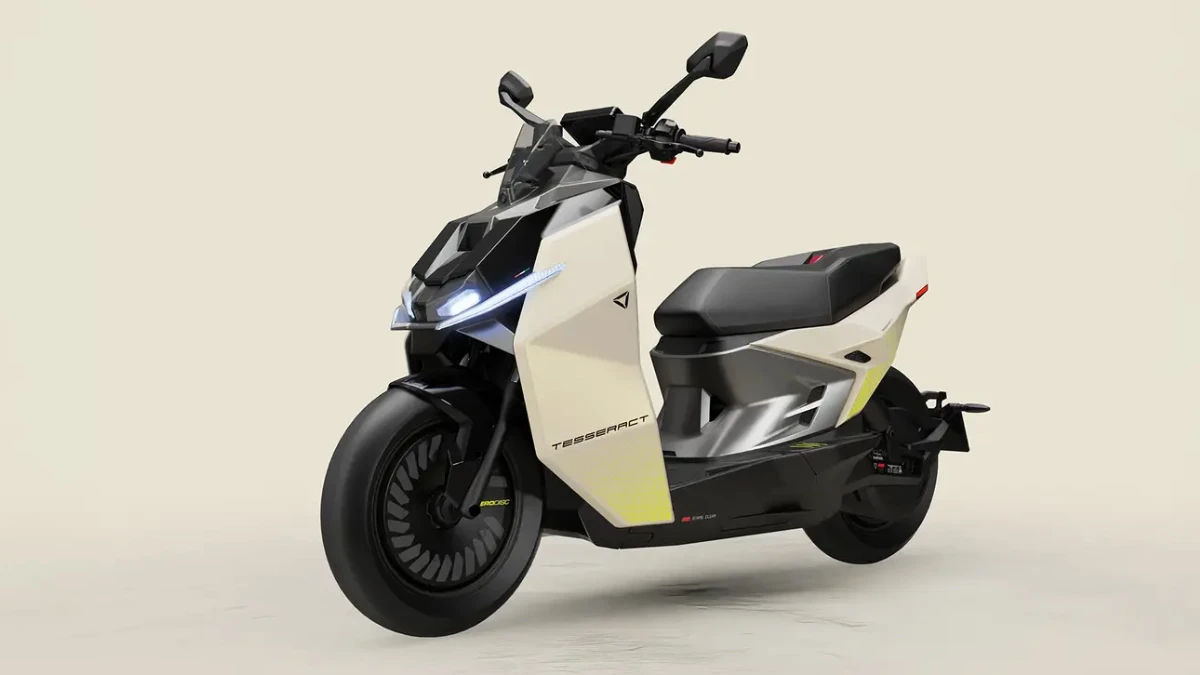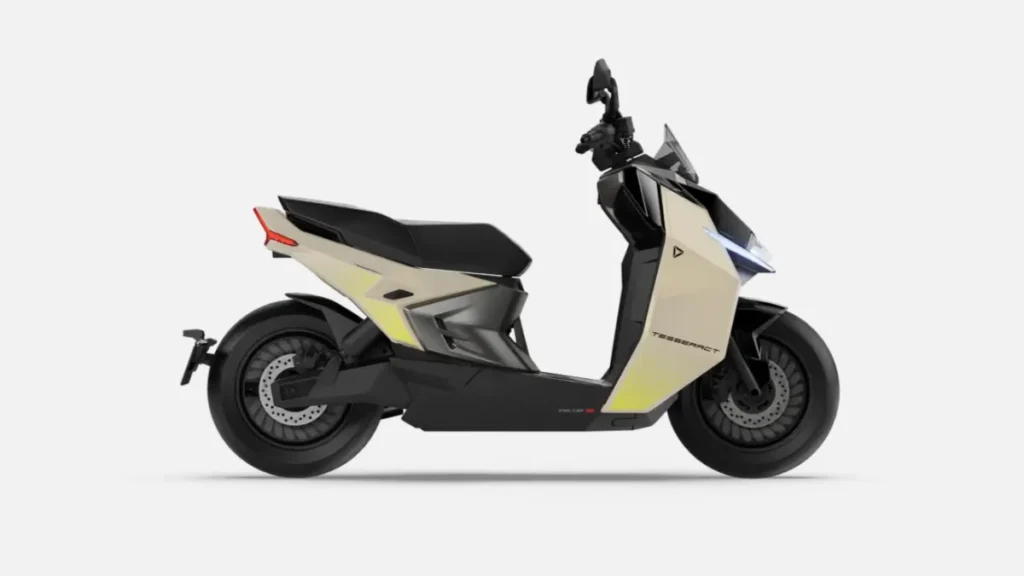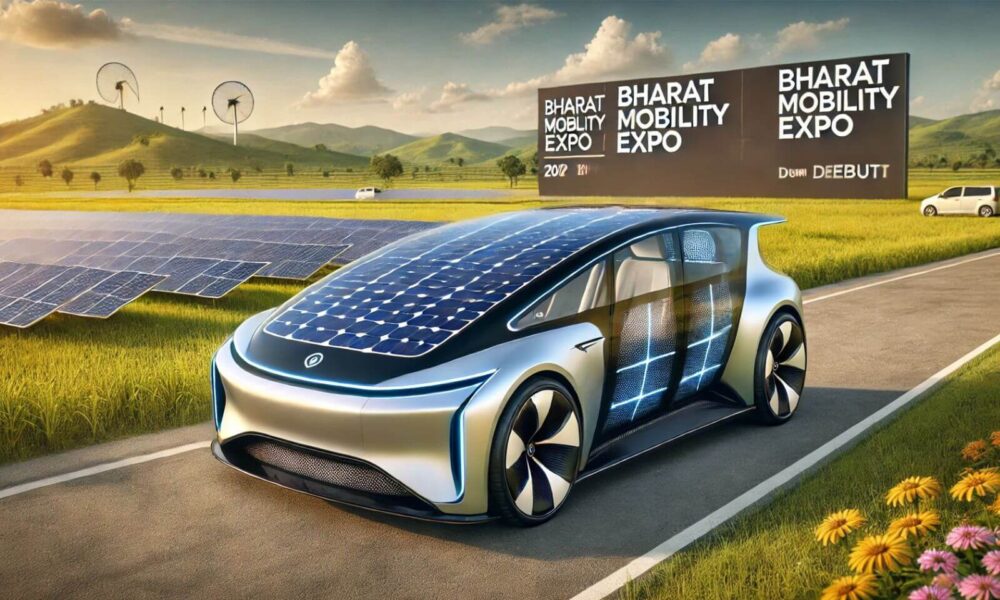EV
India First Solar Powered EV Sustainable Transport
India’s first solar-powered electric vehicle is set to transform sustainable transportation by reducing carbon emissions and offering a cleaner, cost-effective solution for the future.

India is set to make a significant leap toward sustainable transport with the launch of its first solar-powered EV at the Bharat Mobility Expo. This groundbreaking innovation aims to revolutionize the country’s automotive industry by offering a greener, more efficient alternative to traditional vehicles.
With rising pollution and heavy dependence on fossil fuels, this solar-powered EV is an important step toward cleaner transportation. By utilizing India’s abundant sunlight, the vehicle aims to reduce carbon emissions while providing a cost-effective solution to transportation challenges. This renewable energy vehicle could pave the way for a greener future on India’s roads, helping the country achieve its green mobility goals.
“Key Features and Innovations”
This solar-powered EV is designed with cutting-edge technology.
High-efficiency solar panels are built into the car, allowing it to convert sunlight into energy. This energy is stored in advanced lithium-ion batteries, providing a reliable power source that doesn’t rely entirely on charging stations. This improves energy sustainability, making it a great option for both urban and rural drivers.
Key features include:
• Solar Panel Integration: Efficient panels that capture maximum solar energy.
• Enhanced Battery Efficiency: Long-lasting lithium-ion batteries for longer travel distances.
• Dual Charging Mode: A backup charging option to ensure power during low sunlight.
• Smart Energy Management: AI technology to optimize energy use and improve vehicle performance.
“A Turning Point for India’s Automotive Industry”
The introduction of this solar-powered EV could transform India’s automotive market.
Government initiatives, like the FAME (Faster Adoption and Manufacturing of Hybrid and Electric Vehicles) scheme, are already driving the adoption of electric vehicles in India. Solar-powered EVs offer a solution to key challenges, such as reliance on charging stations and range anxiety.
In addition, the affordability of solar energy makes these vehicles more accessible, helping to drive EV adoption across a broader audience. The launch supports India’s goal to reduce greenhouse gas emissions and reach carbon neutrality by 2070. This marks a major step in the nation’s journey toward sustainable transport and green mobility.
“Challenges and Opportunities”
Despite its promise, the solar-powered EV faces a few challenges.
The effectiveness of solar panels can be impacted by weather conditions, especially during the monsoon season, which could reduce energy generation. Additionally, the initial cost of the vehicle may be higher due to the advanced technology. However, as production increases and with government incentives, these issues can be addressed, making renewable energy vehicles more accessible.
“A Vision for a Greener Future”
India’s first solar-powered EV is more than just a technological achievement; it’s a step toward a cleaner, more sustainable future. By using renewable energy, this innovation helps tackle environmental concerns and sets the foundation for solar-powered transportation in the future.
As the world continues to focus on climate change, India’s move into solar-powered vehicles positions the country as a leader in renewable energy solutions. The unveiling of this EV at the Bharat Mobility Expo will inspire further innovations in green technology.
India’s solar-powered EV is a symbol of progress and hope, lighting the way toward a more sustainable future for generations to come.
Watch and Subscribe to the YouTube Channel: EBT Entrepreneur Business Times
Useful Topics:
Entrepreneur Business Times | EBT – Entrepreneur Business Times | Entrepreneurship Latest News & Headlines | Business News | Startup News | CEO Interviews | Automotive News | Pharmaceutical News | FMCG News | Electric Vehicle News | Electrical and Electronics News | Sanitary and Hardware News | Technology News | Politics News | Fashion News | Sports News | Education News | Entertainment News | Video| Entrepreneur Media India | Business News Live | Share Market News | Business Times | Entrepreneurship News India | Entrepreneurship News today | Awards for entrepreneurs in India | Young Entrepreneur Awards India | Latest entrepreneurs in India | Starting a Business | Entrepreneurship in India | Entrepreneur Magazine | Business News Live | Entrepreneur Motivation | Entrepreneur Mindset | Entrepreneur podcast | Entrepreneur | How to become an Entrepreneur | How to be an entrepreneur
Auto
Ultraviolette Tesseract Scooter Launched with AI, 20.1bhp Power, Starts from ₹1.45 Lakh

Ultraviolette Tesseract Scooter Launched with AI, 20.1bhp Power, Starts from ₹1.45 Lakh — and honestly, it feels more like a spaceship than a scooter. This isn’t just another electric ride; it’s a smart scooter with AI features that think while you ride.
With a massive 20.1bhp of power (yep, that’s motorcycle-level muscle), it’s quick enough to surprise even hardcore petrolheads. Starting at just ₹1.45 lakh, it gives you supercar-like tech in a two-wheeler. Oh, and the top model? It throws in a fast charger and premium paint that’ll make your neighbors do a double-take.
Remember when electric scooters were those wimpy little things that struggled up hills? Yeah, those days are officially dead.
Ultraviolette just dropped their Tesseract electric scooter in India, and it’s a game-changer in every sense. With 20.1bhp of power (that’s motorcycle territory), AI-powered features, and performance that’ll make petrol heads do a double-take.
For tech and EV enthusiasts looking at the Ultraviolette Tesseract scooter, you’re getting supercar-level connectivity in a two-wheeler that starts at ₹1.45 lakh. The top variant even throws in a fast charger and premium paint.
But here’s what everyone’s wondering: can this futuristic machine deliver the thrill that makes riding worthwhile?
Ultraviolette Tesseract: Revolutionary Design and Features

Striking Aesthetic and Build Quality
The Tesseract’s design turns heads with its futuristic silhouette and premium materials. Unlike anything on Indian roads, it blends aggressive lines with functional aerodynamics. The high-grade aluminum frame doesn’t just look good—it’s built to last while keeping weight down for better performance and handling.
Advanced AI Integration System
Ever wish your scooter knew what you needed before you did? The Tesseract’s AI system learns your riding patterns, adjusting performance parameters automatically. It optimizes power delivery, predicts maintenance needs, and even suggests route changes based on battery status and riding conditions.
Smart Connectivity Features
The Tesseract isn’t just a scooter—it’s your digital companion. The smartphone integration goes beyond basics with real-time diagnostics, over-the-air updates, and customizable riding modes. You can track vehicle location, set geo-fencing boundaries, and share ride data with friends through the intuitive app.
Unique Tesseract Technology Explained
The revolutionary quad-tilting mechanism is what makes the Tesseract special. This patented system allows all four wheels to tilt simultaneously during cornering, combining the stability of a four-wheeler with a bike’s leaning dynamics. The result? Unmatched handling and safety that redefine electric mobility.
Pricing Structure and Value Proposition
A. Base Model at ₹1.45 Lakh
The entry-level Ultraviolette Tesseract doesn’t skimp on features despite its competitive ₹1.45 lakh price tag. You’re getting serious bang for your buck with that 20.1bhp power output, AI integration, and cutting-edge design. Compared to similar performance scooters, the Tesseract stands out as a premium yet accessible option for tech-savvy riders who want electric power without breaking the bank.
Riding Experience and Handling
A. Suspension and Braking System
The Tesseract’s adjustable suspension eats bumps for breakfast, giving you that floating-on-air feeling even on Mumbai’s pothole paradise. Paired with disc brakes that grip like your grandma at a family reunion, you’ll stop on a dime without breaking a sweat.
B. Comfort Features for Daily Commuting
Forget those painful rides that leave you walking funny. The Tesseract’s ergonomic seat feels like your favorite couch, while the adjustable handlebar position means no more T-rex arms or orangutan stretching. Your daily commute just got a serious upgrade.
The Ultraviolette Tesseract redefines electric scooters with its revolutionary design, impressive 20.1bhp power output, and cutting-edge AI integration. Its advanced battery technology delivers exceptional range while intelligent riding features provide unmatched control and safety. The scooter’s handling capabilities and performance specifications position it as a formidable competitor in the premium electric two-wheeler segment.
Starting at ₹1.45 lakh, the Tesseract offers compelling value despite its premium pricing, considering its innovative technology, performance capabilities, and unique design elements. For riders seeking a blend of sustainability, cutting-edge features, and exhilarating performance, the Ultraviolette Tesseract represents the future of urban mobility that’s available today.
EV
Indias Electric Vehicle Revolution
India’s shift to electric vehicles is transforming the automotive industry, driven by government support, long-range models, and environmental awareness.

India’s automotive sector is rapidly evolving as electric vehicles (EVs) gain popularity across the country. Traditionally dominated by petrol and diesel cars, the market is now shifting toward greener, cleaner alternatives. This transformation is driven by environmental concerns and government efforts to reduce carbon emissions, positioning EVs as a vital part of India’s future. The growing adoption of electric vehicles in India is not just a trend but a necessary step towards sustainable mobility.
“The Rise of Long-Range Electric Cars”
One major reason for this shift is the introduction of long-range electric cars.
Earlier, EV models faced criticism for their limited range and high prices. However, advances in battery technology have enabled modern electric vehicles to offer longer ranges and better efficiency. Popular models like the Tata Nexon EV Max, Mahindra XUV400 EV, and Hyundai Kona Electric are attracting more customers due to their affordability and practical features. These vehicles are now offering consumers greater value with improved range and performance, making EV adoption more appealing.
“Government Support for Electric Vehicles”
The Indian government plays a crucial role in promoting the adoption of electric vehicles in India.
Through the Faster Adoption and Manufacturing of Hybrid and Electric Vehicles (FAME) scheme, the government provides financial incentives to both manufacturers and buyers. These government incentives for EVs include subsidies, lower GST rates, and support for developing EV charging infrastructure. This push makes electric vehicles more affordable and accessible, accelerating the shift toward clean energy in India.
“State Government’s Role in Promoting EVs”
In addition to national policies, state governments are also pushing for greater EV adoption.
States like Delhi, Maharashtra, and Tamil Nadu have introduced their incentives, such as road tax exemptions, subsidies for EV purchases, and plans to expand charging networks. These state-level initiatives have significantly reduced the cost of owning an EV, making them an attractive alternative to traditional petrol or diesel vehicles, particularly in the context of growing environmental concerns.
“Growing Environmental Awareness”
Environmental concerns are another driving force behind the shift toward electric vehicles.
As air pollution worsens in major cities like Delhi and Mumbai, more consumers are prioritizing eco-friendly options. Electric vehicles, with their zero tailpipe emissions, are a sustainable choice that aligns with global efforts to reduce carbon footprints and fight climate change. This growing awareness is a key factor in accelerating the demand for electric mobility in India.
“Expanding EV Charging Infrastructure”
A critical factor in the rise of electric vehicles in India is the development of a robust charging infrastructure.
The Indian government, along with private companies like Tata Power, Ather Energy, and EVgo, is investing heavily in setting up a nationwide network of fast-charging stations. With EV charging stations becoming more available in both urban and rural areas, consumers are more confident that they can easily charge their EVs, addressing concerns about range anxiety and supporting the continued adoption of electric vehicles.
“Challenges in EV Adoption”
Despite the positive momentum, several challenges remain in the journey toward widespread EV adoption.
The high initial cost of electric vehicles, limited charging stations in rural areas, and reliance on imported batteries continue to pose obstacles. To address these, the Indian government has launched the Production Linked Incentive (PLI) scheme to promote local battery manufacturing. This initiative aims to reduce India’s dependency on imports, making EVs more affordable and promoting a sustainable, clean energy future for the country.
Conclusion: A Greener Future
India is on the verge of a major shift toward electric mobility. With the increasing availability of long-range electric cars, government incentives, growing environmental awareness, and expanding charging infrastructure, the adoption of electric vehicles in India is set to grow. As India embraces electric vehicles, it is paving the way for a cleaner, more sustainable future, contributing to global clean energy goals and setting a positive example for other nations.
Watch and Subscribe to the YouTube Channel: EBT Entrepreneur Business Times
Useful Topics:
Entrepreneur Business Times | EBT – Entrepreneur Business Times | Entrepreneurship Latest News & Headlines | Business News | Startup News | CEO Interviews | Automotive News | Pharmaceutical News | FMCG News | Electric Vehicle News | Electrical and Electronics News | Sanitary and Hardware News | Technology News | Politics News | Fashion News | Sports News | Education News | Entertainment News | Video| Entrepreneur Media India | Business News Live | Share Market News | Business Times | Entrepreneurship News India | Entrepreneurship News today | Awards for entrepreneurs in India | Young Entrepreneur Awards India | Latest entrepreneurs in India | Starting a Business | Entrepreneurship in India | Entrepreneur Magazine | Business News Live | Entrepreneur Motivation | Entrepreneur Mindset | Entrepreneur podcast | Entrepreneur | How to become an Entrepreneur | How to be an entrepreneur
EV
India New Guidelines EV Charging Stations Sustainable Mobility
India’s new guidelines for EV charging stations under the PM E-DRIVE initiative will improve charging infrastructure, supporting India’s shift to electric mobility.

The Indian government is taking significant action to encourage the adoption of electric vehicles (EVs). It has released new draft guidelines for establishing EV charging stations under the PM E-DRIVE initiative. These guidelines are aimed at addressing one of the key challenges hindering EV growth—insufficient charging infrastructure, which is crucial for expanding India’s EV infrastructure.
“Addressing the Charging Infrastructure Gap”
As EV sales in India grow, the lack of accessible and reliable charging stations remains a major issue. The government understands that improving charging infrastructure is essential for the country’s transition to electric mobility. Through the PM E-DRIVE initiative, the government plans to build a nationwide network of EV charging stations, with a particular focus on fast charging solutions. This initiative is designed to improve EV infrastructure across both urban and rural areas, making electric vehicles more accessible.
“Key Features of the Guidelines”
The draft guidelines lay out a comprehensive plan for setting up EV charging stations across the country.
The primary goal is to establish fast-charging stations, especially along highways and major transportation routes. This will help tackle range anxiety and the fear of running out of battery power without access to a nearby charging station.
To support the development of these stations, the government will offer up to 80% subsidy on the infrastructure costs. This financial aid will make it more affordable for businesses, local governments, and private operators to invest in EV charging stations in urban, semi-urban, and rural areas. By doing so, the government is helping to expand India’s EV infrastructure, making it easier for electric vehicles to thrive in all regions of the country.
“Government’s ₹2,000 Crore Investment”
As part of the PM E-DRIVE initiative, the government has allocated ₹2,000 crore to fund the development of public fast-charging stations. These stations are crucial for making EV ownership practical, offering quick and convenient charging in urban centers, along highways, and in industrial zones. Special attention will also be given to expanding charging options in rural and remote areas.
This substantial investment in EV infrastructure is expected to create jobs in the renewable energy sector, supporting India’s economic growth and contributing to its sustainability goals. By investing in EV charging stations, the government is furthering its commitment to sustainable mobility.
“The Future of EV Charging Infrastructure”
The release of these guidelines marks a significant step in India’s shift toward electric vehicles. With strong government support, the development of a robust charging infrastructure will help speed up EV adoption, reduce reliance on fossil fuels, and contribute to the country’s environmental targets.
Successful implementation of the guidelines will require collaboration between the government, the private sector, and local authorities. The success of the PM E-DRIVE initiative will depend on the timely establishment of EV charging stations and active participation from all stakeholders in building the necessary infrastructure for sustainable mobility.
“Conclusion:”
In conclusion, the new guidelines for EV charging stations are a vital move toward a cleaner and greener India. The financial support and ₹2,000 crore investment in fast-charging stations will pave the way for a sustainable EV future, promoting cleaner mobility and driving economic growth across the country. These efforts are an essential part of India’s broader push toward a more sustainable and eco-friendly future, supported by strong EV infrastructure and the growing adoption of electric vehicles.
Watch and Subscribe to the YouTube Channel: EBT Entrepreneur Business Times
Useful Topics:
Entrepreneur Business Times | EBT – Entrepreneur Business Times | Entrepreneurship Latest News & Headlines | Business News | Startup News | CEO Interviews | Automotive News | Pharmaceutical News | FMCG News | Electric Vehicle News | Electrical and Electronics News | Sanitary and Hardware News | Technology News | Politics News | Fashion News | Sports News | Education News | Entertainment News | Video| Entrepreneur Media India | Business News Live | Share Market News | Business Times | Entrepreneurship News India | Entrepreneurship News today | Awards for entrepreneurs in India | Young Entrepreneur Awards India | Latest entrepreneurs in India | Starting a Business | Entrepreneurship in India | Entrepreneur Magazine | Business News Live | Entrepreneur Motivation | Entrepreneur Mindset | Entrepreneur podcast | Entrepreneur | How to become an Entrepreneur | How to be an entrepreneur



















